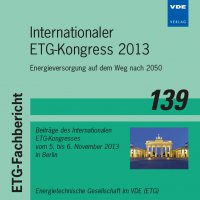Transformation of the Energy System in Germany – Enhancement of System Stability by Integration of innovative Multilevel HVDC in the AC Grid
Conference: Internationaler ETG-Kongress 2013 – Energieversorgung auf dem Weg nach 2050 - Symposium 1: Security in Critical Infrastructures Today
11/05/2013 - 11/06/2013 at Berlin, Deutschland
Proceedings: Internationaler ETG-Kongress 2013 – Energieversorgung auf dem Weg nach 2050
Pages: 6Language: englishTyp: PDF
Personal VDE Members are entitled to a 10% discount on this title
Authors:
Dorn, Joerg; Pohl, Manfred; Retzmann, Dietmar; Schettler, Frank (Siemens AG, Erlangen, Germany)
Abstract:
Globally, deregulation and privatization are posing new challenges on high voltage transmission and on distribution systems as well. An increasingly liberalized market will encourage trading opportunities to be identified and developed. Environmental constraints, such as energy saving, and CO2 reduction, also play an important role. The loading of existing power systems will further increase, leading to bottlenecks and reliability problems. Consequently, we have to deal with an area of conflicts between reliability of supply, environmental sustainability as well as economic efficiency. Furthermore, in Germany, the transition from well-proven Energy-Mix to the new Energy-Transition (“Energie-Wende”) with large amounts of volatile Regenerative Energy Sources (RES), e.g. over 30 GW solar power on medium and even low voltage level, in combination with over 30 GW of wind power (at present – mainly onshore) plus high amounts of offshore wind power in the future (30 to 50 GW – long-term) in combination with the scheduled shut-down of all nuclear power plants will make the power supply highly sensitive to any kind of system disturbance, finally leading to brownouts and blackouts. High voltage power electronics, such as HVDC (High Voltage Direct Current) and FACTS (Flexible AC Transmission Systems) provide the necessary features to avoid technical problems in heavily loaded power systems; they increase the transmission capacity and system stability very efficiently, and they assist in prevention of cascading disturbances. Furthermore, they effectively support the grid access of renewable energy resources and they reduce the transmission losses by optimization of the power flows. HVDC offers most important advantages: it can be used as fully controlled bulk power energy highways from North to South and East to West all across Europe and for the northern wind farm grid access as well. Another big benefit of HVDC is its incorporated ability for fault-current blocking, which is not possible with synchronous AC links. In addition, the HVDC, integrated into the AC grid can effectively support the surrounding AC system in case of transient fault conditions, e.g. power oscillation damping and it serves as firewall against cascading disturbances. Therefore, the strategies for the development of power systems with high amounts of RES go clearly in the direction of hybrid transmissions, consisting of DC and AC interconnections and point-to-point bulk power transmission “highways” (DC Backbones plus FACTS in the AC systems). Especially when the HVDC is equipped with the latest technology of modular multilevel converters (MMC Full Bridge, HVDC PLUS), the strategy for fault clearance along the DC transmission line can be best adapted to the specific AC and DC system conditions with focus on fast and effective fault recovery (e.g. up to 3 fully controlled restart attempts, more effective than any AC fault clearance), including fast power and voltage ramping or reversal (if necessary) and dynamic damping functions. In what follows, the benefits of projects with the HVDC integrated into an AC grid will be depicted. Experience and prospects of the HVDC “classic” and the multilevel VSC HVDC in both half bridge and full bridge technology will be discussed with regard to the system performance.


